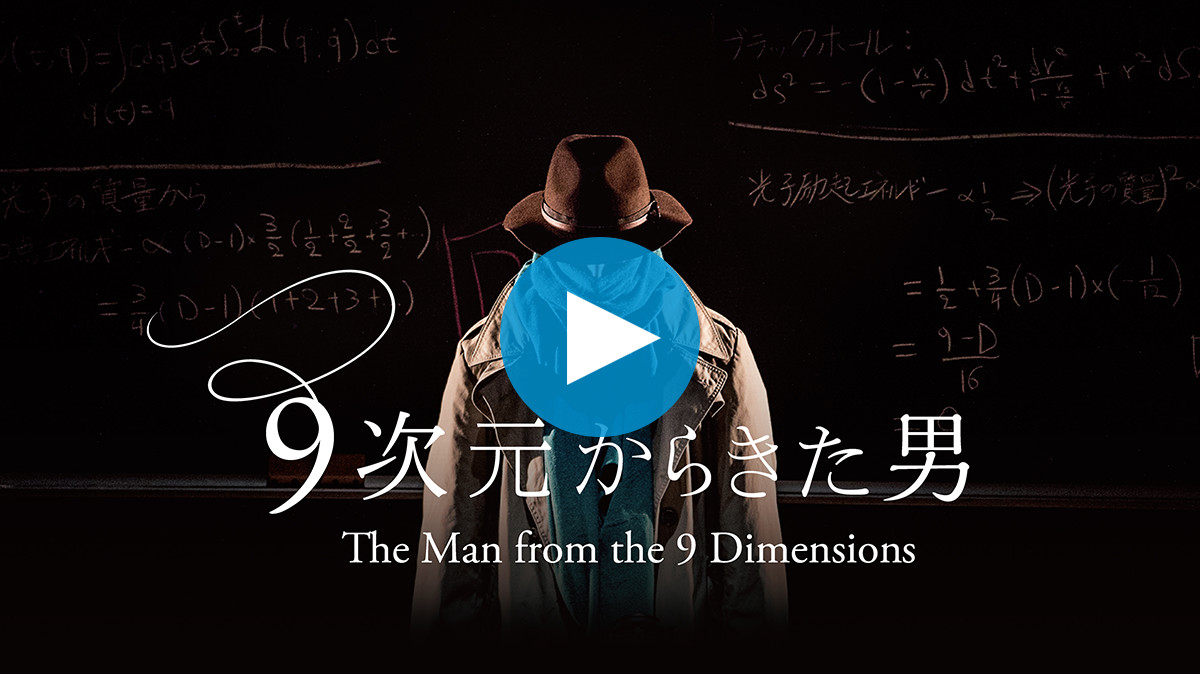
“The movie ‘The Man from the 9 Dimensions’ was born from our desire to explain physics to the general public and what physicists are striving to discover. One of the missions of physics is to discover the fundamental laws of the natural world and to use them to address such profound questions as how our beautiful Universe began. We wanted to use this movie to show how scientists are pursuing this goal.”
 photo: Chieko Kobayashi
photo: Chieko Kobayashi“Since the dawn of history, humans have continually being asking such questions as ‘How did the Universe begin?’, ‘What is the Universe made of?’, and ‘What is our place in this Universe?’ Philosophies and religions that have emerged over the millennia can all trace their origins to these questions. However, 400 years ago, we began to approach these questions from an entirely different angle: the scientific method. It started with Galileo Galilei pointing his telescope toward the night sky and opening up a whole new window onto the Universe, enabling us to use the scientific method to unravel the mysteries of the cosmos. This triggered what has been called the ‘Scientific Revolution.’ Over the 400 years since then, we have made tremendous progress toward understanding the Universe.”

“Current research suggests that the Universe came into being 13.8 billion years ago in a high-temperature, highly dense state. This was what we call the ‘Big Bang.’ The General Theory of Relativity that Einstein discovered in 1915 made it possible to study the birth and the evolution of the Universe in a scientific fashion. There are three pieces of evidence for the Big Bang: Hubble’s discovery that the Universe has been expanding, the calculation of the ratio of hydrogen atoms to helium atoms created within three minutes of the beginning of the Universe, and the observation of light emitted 400,000 years later. The Big Bang was followed by a period called the ‘Dark Ages’ of the Universe; at the end of the Dark Ages, the first stars were born, structures were formed, the Galaxy came into being, and 9 billion years later, the sun and the Earth were formed creating our solar system. The first life was born on Earth 3.5 billion years later, gradually evolving into humankind over a very long period of time, and eventually reached the stage at which we began to ask ‘Why was the Universe formed?’ and ‘What is our place in it?’ The fact that the Universe had slowly developed over a period of 13.8 billion years is absolutely crucial to our birth as intelligent life. But why has the Universe lasted for such a long time? This is one of the biggest mysteries of the Universe. To understand it, we need to study the Universe's beginning.”

“What would we see if we traced our way back to 0.0001 second after the birth of the Universe? Even the protons and neutrons were disintegrated into quarks, and the Universe was like a scorching hot soup with elementary particles flying around everywhere. We actually have a theory to describe such a soup; the so-called Standard Model summarizes our current understanding of the world of elementary particles. The theory has been verified over and over again by many experiments at the microscopic level. With that theory we can explain, in precise quantitative terms, what happened between 0.0001 to 0.00000000001 of a second after the birth of the Universe! That is to say, in the fraction of time in which there are 10 zeros after the decimal point. However, the Standard Model is not perfect. Current observations of the Universe suggest that matter that can be explained by the Standard Model account for just 5% of the Universe as a whole. Another 27% is thought to be dark matter, while the remaining share of almost 70% consists of a mysterious type of energy called dark energy. Thus, after working so hard to study the Universe over the last 400 years, we find ourselves knowing only about 5% of it. So, what was happening before the epoch of the Standard Model? To discover this, we will need a more fundamental theory; a theory that goes beyond the Standard Model.”

“One of the most promising hypotheses for the much earlier state of the Universe is the so-called cosmic inflation. To gain a precise, quantitative understanding of this inflationary stage of the Universe, we need a theory that unifies the law of gravity in the macroscopic world and the law of elementary particles in the microscopic world. The most promising is the superstring theory. In the superstring theory, the ultimate basic building blocks of matter are ‘strings’ rather than ‘point particles.’ This is still only a hypothesis and has yet to be proven experimentally. In the superstring theory, even the notion of dimensions of space also needs to be reconsidered. This movie explores a world in 9 dimensions predicted by the superstring theory. We humans experience space as 3 dimensions, so this means that there must be 6 extra dimensions. It is expected that these 6 extra-dimensions are curled into a compact “Calabi-Yau ” space that cannot be observed directly.
One of the challenges for us theoretical physicists is to derive quantitative predictions on elementary particles from the geometric structure of Calabi-Yau spaces. Calabi-Yau space is highly complex and its structure is still not well understood, even by mathematicians. Solving this is one of my research agenda, but I am afraid that we will have to leave its discussion for another time.”
“The film ‘The Man from the 9 Dimensions’ depicts the physicists who are trying to discover the ultimate unified theory that combines the laws of the macroscopic world, namely the theory of gravity to try to understand the Universe, and the laws of the microscopic world, namely quantum mechanics and elementary particle theory. In the world of theoretical physics, the power of mathematics is very important. I want to combine the power of mathematics with results of experiments and observations to solve the mysteries of the Universe. Although we have not yet understood what he, T.o.E. is, I want to get as close to him as I can in my own limited life. I hope that the next generation will pick up the search where I leave off.”

